The use of leverage in cryptocurrency trading operates similarly to that in the forex market. By using this tool, traders can utilize broker funds and increase potential profits. However, at the same time, this also increases the risks. Overusing leverage can lead to traders losing most of their funds. After reading this article, you will understand how leverage works in cryptocurrency trading and what advantages and risks it entails. This article also covers topics related to managing risks to profit from borrowed funds. It is essential to understand the differences between cryptocurrency leveraged trading and traditional forms of investment (such as spot trading or non-leveraged trading).
What is Leverage in Cryptocurrency Trading? A Guide to Maximizing Returns
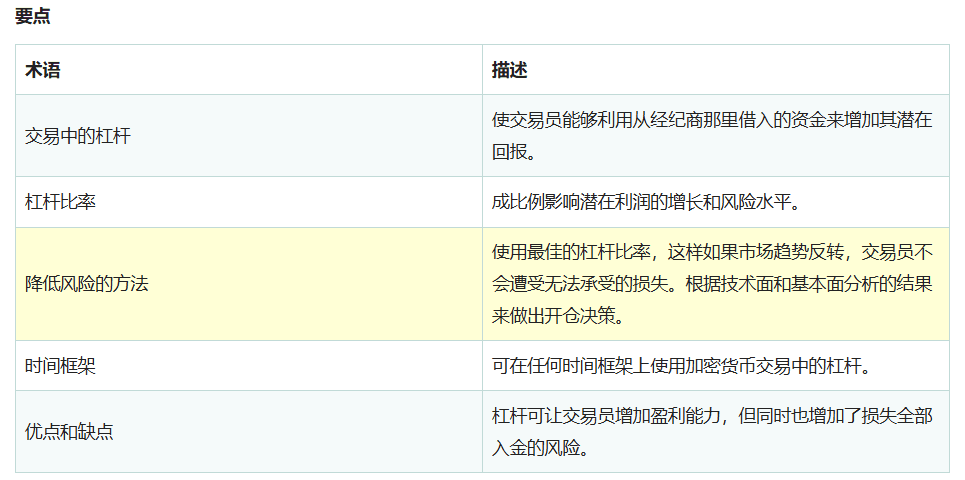
What is Leverage in Cryptocurrency Trading?
First, let's look at leverage and margin trading in trading. There are mainly two basic types of trading:
Long trading
Short selling
In long trading, traders buy assets at a fixed price and sell them at a higher price. Thus, even without the participation of an exchange or broker, traders can profit by buying cryptocurrency and reselling it. Short selling is based on different principles. Traders borrow assets from brokers, sell them, and then, after the price drops, buy back the tokens and return them to the broker. When trading cryptocurrency without leverage, all trades are made using the available funds in the trader's account and at the current market price. However, short selling is already referred to as margin trading, even when trading without leverage, as the trader has borrowed assets from the broker. This mechanism is also used on platforms focusing on cryptocurrency leveraged trading and cross-margin trading, providing greater flexibility for risk management. Leverage in cryptocurrency trading gives traders greater purchasing power by borrowing capital. By using leverage, traders can significantly increase their position size and the chances of acquiring higher profits. However, it is essential to remember that since only the available balance in the account can be used as collateral, market trends may negatively affect your position. The higher the leverage ratio, the greater your profit for each point of price movement, but at the same time, the closer you are to the liquidation level, which can lead to significant losses.
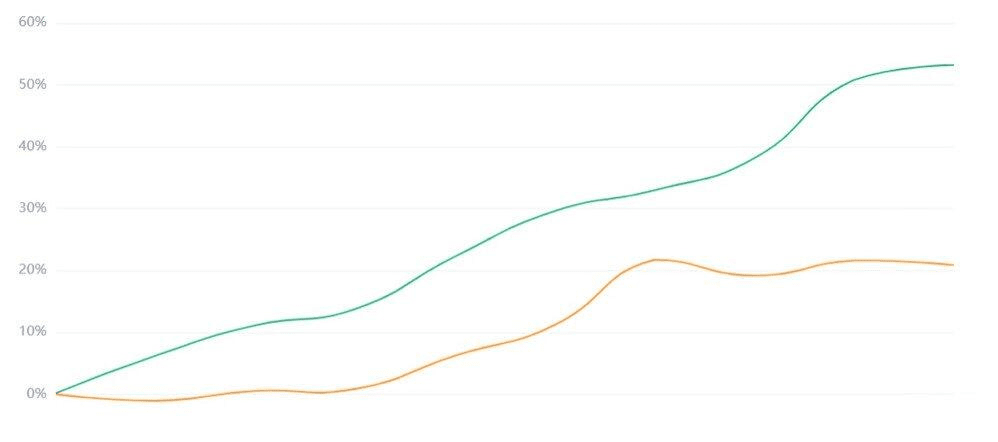
The above chart shows the profitability of BTCUSD (Bitcoin/US Dollar) leveraged trading (green line) compared to non-leveraged trading (yellow line)
How Does Cryptocurrency Leveraged Trading Work?
To use leverage, traders must have margin. The account balance (positive value) serves as collateral, as part of the trade is secured with the trader's funds. The higher the leverage ratio, the smaller the trader's share. The remaining amount is covered by the broker. After entering long/short trades, traders need to maintain a certain margin threshold. For most brokers, margin requirements are limited to 25%. If the margin is insufficient, brokers will issue margin call notifications, requiring traders to top up their accounts and initiate compulsory liquidation procedures. This is a necessary process that prevents the account balance from turning negative, so traders do not owe brokers money.
Example of long trading with leverage
To better understand what leverage is, let's use the following data to see how it works: · Trader's balance: $100; · Trading volume: $1,000; · Ratio: 1:50; · Trade type: Long trade.

To open a long position with leverage at a trading volume of $1,000, the trader must have $1,000/50 = $20 in collateral. While it seems that minimal funds are needed to trade cryptocurrencies with leverage, it is indeed the case as long as the price fluctuates in the predicted direction. In cryptocurrency leveraged trading, one mistake can lead to the immediate liquidation of the leveraged position. Even if the market price drops by just $1, the margin will increase by $50 as specified. If the market price drops by $2, the available funds in the account will not be sufficient to continue trading with leverage because the margin call notification will be triggered before the quote drops by $2; that is, the position will be liquidated. If the trader chooses a lower leverage ratio, the risk of liquidation will decrease. For instance, when using 1:10 leverage, if the price drops by $1, the margin requirement will only increase by $10. In a positive scenario, the borrowed funds will yield considerable profits for the trader. If a leverage ratio of 1:50 is used, a mere $3 price increase will yield a net profit of $150 for the trader.
Example of short selling with leverage
Let's consider the characteristics of borrowing assets and leveraged trading using the following data: · Trader's balance: $5,000; · Trading volume: Buying BTC for $10,000; · Ratio: 1:50; · Trade type: Short trade. If you open a leveraged trade with a 1:50 leverage ratio and a trading volume of $10,000, your initial margin will be $10,000/50 = $200. As the price drops, for every $1 drop in the currency exchange rate, the trader will earn $50. If the price reverses above the entry point level, then for every $1 increase in price, the trader will lose $50. Therefore, if your balance is $5,000 and the initial margin is $200, the trade will be liquidated when the price rises by $96.

The above chart illustrates how short selling with leverage works. The trader borrows Bitcoin at a high price and sells it at the market price. After the price drops, the trader buys back Bitcoin at a lower price. Due to the lower price of Bitcoin, they have more units. The trader then returns the borrowed amount of Bitcoin and keeps the difference as profit.
Leveraged Tokens
In recent years, a new type of leveraged token has emerged. In addition to Bitcoin, Ethereum, and Tether, traders may also encounter strange names like Ethereum 3x short tokens.

Leveraged tokens are assets typically developed using ERC-20 or EVM-compatible protocols. These tokens are easy to use and trade alongside other assets on exchanges. On the other hand, they allow traders to benefit from financial leverage to increase returns from price changes in the underlying assets without managing margin or borrowing. Compared to margin trading, these tokens have distinct advantages, as there is no need to worry about margin safety and liquidation levels. At the same time, due to the built-in automatic rebalancing mechanism of leveraged tokens, traders cannot hold them for long periods. This mechanism allows traders to maintain leverage at a given level, but it can also adjust the token's value. Additionally, using them may also require paying extra fees and other costs associated with rebalancing. Since such tokens can automatically rebalance, their value may be affected by sudden market fluctuations. Unlike regular ERC-20 tokens, traders cannot withdraw these tokens to their wallets and may incur additional fees while holding them. If the market is in a flat period and prices do not trend for a long time, the rebalancing-related fees and other costs will reduce your balance. These costs can be much higher than those of margin trading conducted with similar leverage ratios.
Why You Should Use Leverage to Trade Cryptocurrencies
Traders use leverage to increase profits from each trade. However, as mentioned above, cryptocurrency leveraged trading can also suffer significant losses. Another reason for using leverage in cryptocurrency trading is to enhance liquidity. For example, instead of choosing 2x leverage to maintain a position in one exchange, traders can use 4x leverage to maintain the same position size with less collateral. This way, he/she can allocate part of the funds for other trades, such as trading other assets, staking, providing liquidity for decentralized exchanges (DEX), or investing in NFTs.
Pros and Cons of Cryptocurrency Leveraged Trading
Using leverage to trade cryptocurrencies has its pros and cons. Properly utilizing leverage and managing risks can allow traders to achieve substantial profits with minimal negative impacts. Ultimately, the trading outcome depends on the effectiveness of the strategy and the trader's ability to assess market sentiment.
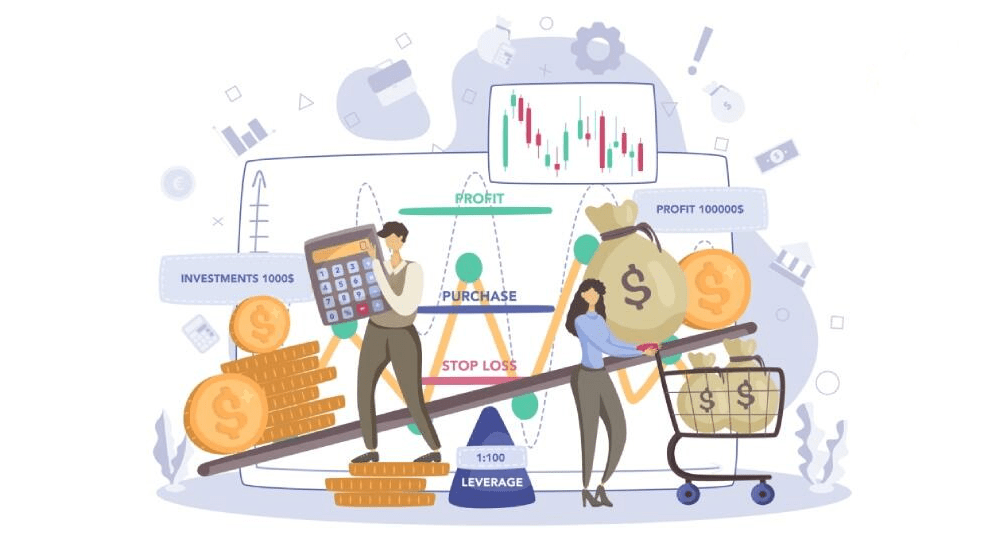
The table below lists the main advantages and disadvantages of using leverage to trade cryptocurrencies. Regardless of the chosen strategy, whether it is spot trading, cross-margin trading, or leveraged trading, it is crucial to understand all potential risks involved.
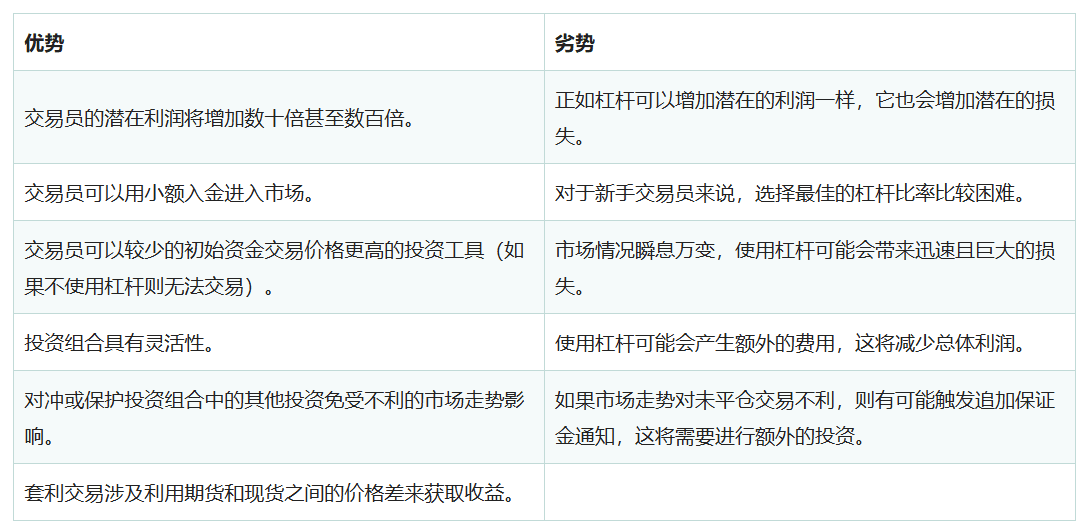
Advantages of Leveraged Trading
In the field of cryptocurrency, traders use leverage to increase financial returns, primarily to increase profits. By using financial leverage, traders can trade higher-priced investment assets that investors with less initial capital would not be able to trade without leverage. Leverage can be used in short-term trading when significant capital is needed, or when traders are confident about future price movements and want to maximize profits.
Disadvantages of leveraged trading
However, leverage has a significant drawback. When using leverage, there is a risk of liquidation. If market trends are unfavorable to your position, high leverage can impose a huge margin burden. If you are a novice trader, I do not recommend using leverage unless you have accumulated sufficient trading experience in regular trading. Improper use of leverage can be fatal for traders. It is crucial to have risk management skills when using leverage. Never trade with borrowed funds or money you cannot afford to lose.
Managing the risks of leveraged trading
Supporters of margin trading are constantly improving risk management methods. This allows for maximizing leverage without worrying about receiving margin call notifications. One fundamental approach is to choose a leverage ratio that allows for significant market price corrections. This is especially true in the cryptocurrency field, as the cryptocurrency market is characterized by higher volatility and lower predictability compared to the forex market. Experienced traders impose additional restrictions on individual tools. For instance, if you plan to trade with leverage in a sideways market, it is better to choose a leverage ratio of 1:5 instead of 1:10. On the other hand, for trend trading, you can use a higher leverage ratio, especially if your trading strategy involves opening long or short trades during an established trend. The following tools can help you minimize losses when using leverage: · Use stop-loss levels to automatically close trades when market trends are unfavorable. When trading cryptocurrencies, it is best to set the stop-loss order at the recent local low to prevent severe retracements and liquidations. · Take profit orders are pending orders that automatically lock in profits when prices exceed a predetermined level. They are particularly helpful for beginners who find it challenging to predict when prices will reach target values. · Limit orders are pending orders that execute trades at a predetermined price. · Trading plan. Plan entry prices, stop-loss prices, average position prices, and profit-taking prices in advance. Do not deviate from your trading plan. · Use isolated margin to limit losses from opening trades. If liquidation occurs, you will only lose the funds allocated for isolated margin in a specific trade, not all your deposits. · Manage liquidation levels. Always monitor liquidation levels. It should maintain a safe distance from your position. When calculating liquidation levels, consider the tool's volatility and the stop-loss level in your trading plan. The main rule of using leverage is to maintain discipline and trade responsibly. Always consider the potential risks involved. It is better to choose lower leverage and obtain smaller profits than to learn from your own experience what liquidation risk is.
Leveraged Trading vs. Spot Market vs. Derivatives Market
Even if you are a novice trader, you may have heard of the spot market. This is the simplest trading method, and almost all centralized cryptocurrency exchanges offer spot trading. The uniqueness of the spot market is that it handles trades backed by physical assets. The traditional spot market is the commodities market (oil, precious metals, grains), where all trades are conducted through an order book. Cryptocurrency trading is similar. Assume all trades in the spot market are backed by cryptocurrencies at a 1:1 ratio. Traders can withdraw these funds at any time. Traders typically use their own assets to complete spot trades, without leverage. However, traders who prefer leveraged trading can also trade in the spot market. It is important to note that leverage in the spot market is lower, and commissions are higher. Leveraged tokens are also tools for leveraged spot trading. When trading derivatives, you are not trading real assets but contracts that guarantee their safety. Derivatives are divided into perpetual contracts and futures contracts. Perpetual derivatives are the most popular in the forex and cryptocurrency markets as they are simpler and more liquid trading tools. A notable feature of derivative financial instruments is the ability to use significant leverage, often exceeding 1:100 or even 1:500. Another advantage of derivative financial instruments is that fees are relatively low.
Regulation
Many inexperienced traders complain of significant losses after using leverage, leading to some states implementing licenses, additional restrictions, and even legislative bans on brokers using leverage.
For instance, in Canada, the CSA banned cryptocurrency leveraged trading after the incident at the FTX cryptocurrency exchange. Officials from the regulatory agency explained that virtual currency trading should ensure the safety of traders and avoid unreasonable risks. The ban on margin trading affects not only institutional investors but also proprietary traders. Singapore has recently implemented similar restrictions but only for retail traders.
In Australia, financial authorities regulate the acceptable leverage ratio for various financial instruments on cryptocurrency leveraged trading platforms instead of completely banning leveraged trading. Since 2020, margin trading in cryptocurrencies has been permitted with a maximum leverage of 1:2, which eliminates the advantages of leverage. At the same time, in terms of risk levels, trading with a 1:2 leverage does not differ significantly from non-leveraged trading.
The Ministry of Finance of the Russian Federation has also taken similar measures to address this issue. In September 2023, the Bank of Russia created a new category of brokerage clients. This includes clients with an initial risk level and who have been using leveraged trading for less than a year. For this category of clients, regulators set lower leverage ratios than those for investors with a standard risk level. The latter are allowed to trade with leverage up to 1:3, but for beginners, this ratio is reduced to 1:1.4.
Leverage Trading Strategies
Leveraged trading is a commonly used method to significantly increase potential returns by leveraging limited personal funds. However, it is crucial to understand how to use leverage wisely and manage risks effectively.
The first step in developing a trading strategy is to choose the best leverage ratio. New traders are advised to use moderate leverage ratios, such as 1:10 or 1:20, to avoid facing excessive risk. Experienced traders can use leverage up to 1:50 or higher, but must strictly adhere to risk management principles.
Ensure to set stop-loss and take-profit orders for each trade. For example, if you are trading the BTC/USD (Bitcoin/US Dollar) cryptocurrency pair, your stop-loss order should limit potential losses to 1%-2% of the capital amount. This approach helps you avoid significant losses during large price fluctuations.
Moreover, market volatility should also be considered. Leveraged trading is most effective in markets with clear trends and moderate volatility. During periods of high uncertainty or extreme price fluctuations, it is advisable to lower leverage ratios or temporarily stop using leverage.
Regularly monitoring the market and developing the ability to respond quickly to changes are key to successful leveraged trading. Additionally, you should conduct technical analysis to determine entry and exit points. Common technical analysis tools include support and resistance levels, trend lines, and indicators such as RSI, MACD, and Bollinger Bands.
Finally, to profit from leveraged trading, continuous learning and practice are essential. Before applying strategies in real trading, it is advisable to test them using a demo account.
Real-life trading example
To better understand the concept of leverage and its advantages, let's look at a real example of using leverage for long trading:
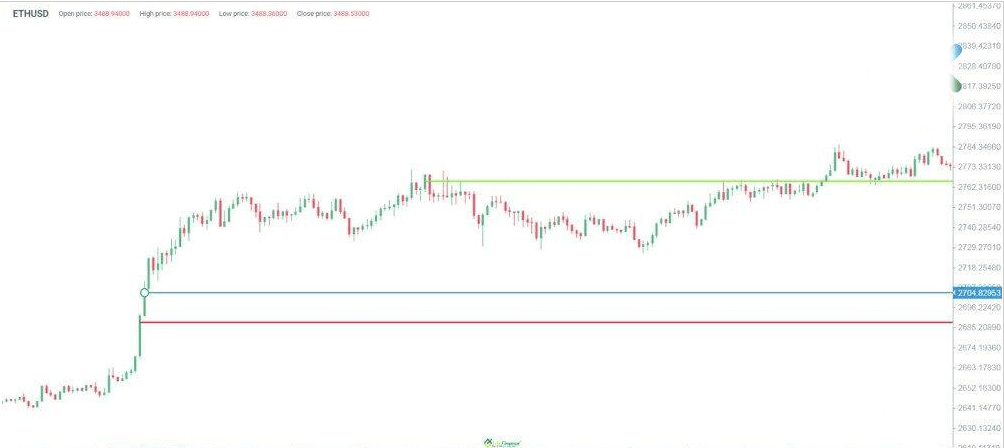
The trader uses Tether (USDT) to deposit $500;
The trader then decides to use 1:20 leverage, as he/she believes that trading with a larger leverage ratio poses too great a risk. When using this leverage, the total value of one trade increases to $10,000;
In the Ethereum market, after the price breaks through the important psychological barrier of $2,700, the trader opens a long position at a market price of $2,705 with a trading amount of $5,000;
The trader then sets the stop-loss at the $2,690 level. If the price of Ethereum drops by $15, the trader will lose $55.45;
On that day, the price of the token rose to $2765;
At this level, the ETHUSDT (Ethereum/Tether) currency pair price encounters strong resistance, and the trader decides to lock in profits. As a result, he/she gains a profit of $221.81 but takes on a risk of losing $55.45.
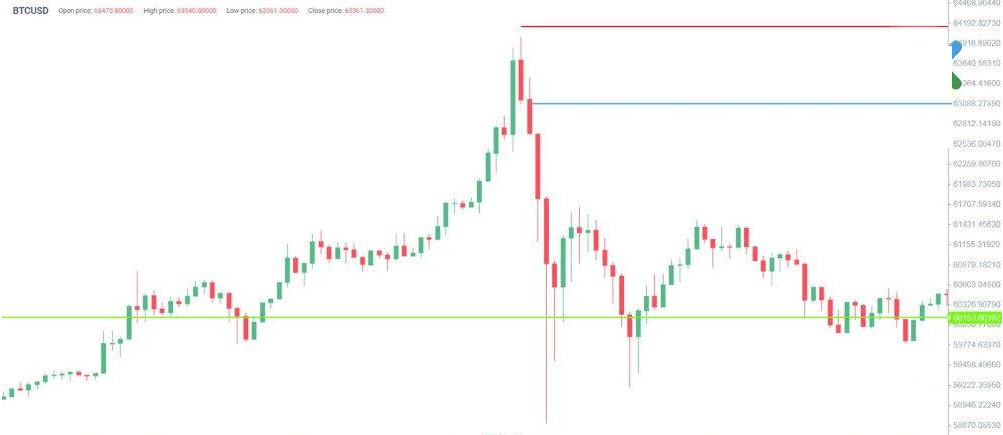
Conclusion
Leveraged trading allows even traders with limited initial capital to make substantial profits. By using broker funds, your purchasing power can increase by 10 times, 50 times, or even 1000 times. It is especially important to use cryptocurrency leveraged trading platforms that offer risk management tools. Whether you are interested in spot trading or cryptocurrency leveraged trading, you should be cautious in choosing a platform. However, as potential profits increase, risks also increase proportionally. Inexperienced traders often lose all their funds if they use large leverage irresponsibly. Therefore, you need to be careful when using this tool, especially when it involves cryptocurrency, as the volatile cryptocurrency market increases the risk of capital loss. Leveraged trading allows even traders with limited initial capital to make substantial profits. By using broker funds, your purchasing power can increase by 10 times, 50 times, or even 1000 times. It is especially important to use cryptocurrency leveraged trading platforms that offer risk management tools. Whether you are interested in spot trading or cryptocurrency leveraged trading, you should be cautious in choosing a platform. However, as potential profits increase, risks also increase proportionally. Inexperienced traders often lose all their funds if they use large leverage irresponsibly. Therefore, you need to be careful when using this tool, especially when it involves cryptocurrency, as the volatile cryptocurrency market increases the risk of capital loss. This article introduces what leverage is in cryptocurrency trading and provides a guide for maximizing returns. For more related content on leveraged trading in the cryptocurrency world, please follow my previous articles or continue browsing the related articles below. I hope everyone pays more attention to me in the future.
Seizing opportunities for future positioning can allow many to cross social classes again in a bull market!
2. Opportunities in altcoin spot trading, sharing wave strategies and long-term strategies in real time!
Now that the market is active again, new star sectors or coins are definitely needed to ignite a new bull market. Catching one will yield great profits; catching several will yield explosive profits!
One tree cannot make a forest, and a lone sail cannot sail far! In the cryptocurrency world, if you don't have a good circle or insider information, I suggest you follow me. I'll help you get on board without investment, and welcome you to join!


